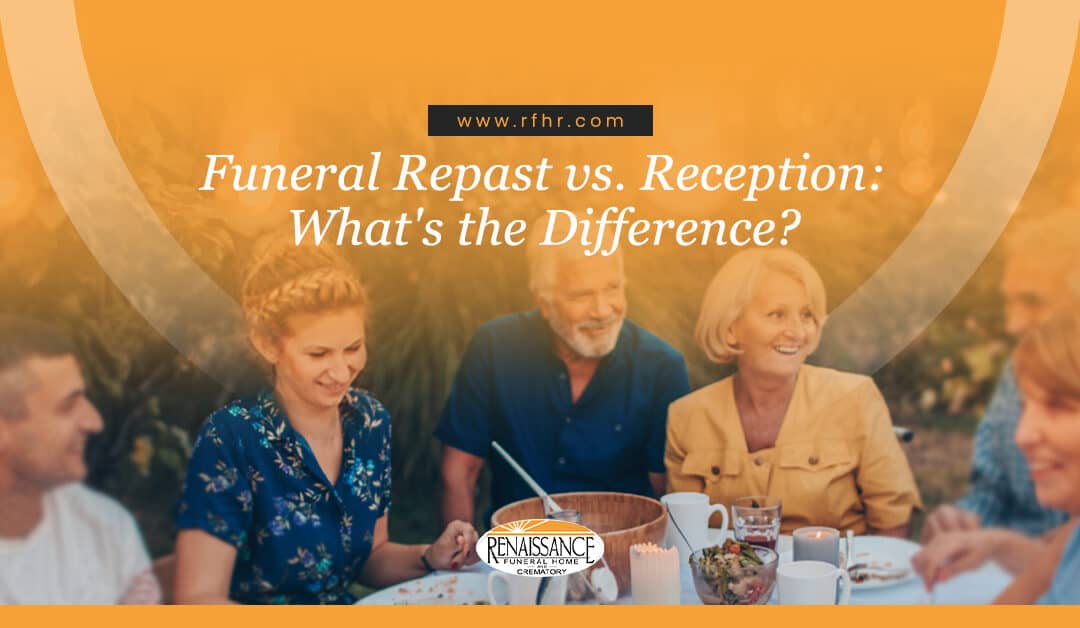When planning a gathering after a funeral service, you may come across the terms “repast” and “reception” and wonder if there’s actually a difference between them. In many circles, these words are used interchangeably, leading to some confusion.
In this blog, we’ll clarify whether there is a distinct difference between a repast and a reception. We’ll also see where these traditions come from and how to remember your loved one with a funeral repast or reception.
“Repast” Means “A Meal”
Dictionary.com defines the word “repast” as a formal term for a meal. You can see that it has Latin and old French roots.
However, in our times, we don’t generally say things like, “What a lovely repast we had with friends today.” or “You’ve planned a sumptuous repast.”
Cultures in the United States now rarely use the term “repast” to discuss a meal eaten with others. However, “repast” can be another term for the meal planned after a funeral or memorial service.
What is a Funeral Repast? A “Meal Eaten after a Funeral”
The term “funeral repast” specifically refers to a meal shared among attendees after a funeral or memorial service. More commonly, people refer to a funeral repast as a “funeral reception.”
Originating from religious and cultural traditions, a repast serves as a communal space for family and friends to gather, eat, and find comfort in each other’s company.
This meal often occurs in a church hall, community center, funeral home, or even a family member’s home. The focus is on togetherness and reflection, providing a setting where attendees can share memories, offer condolences, and begin the healing process.
What is the History of Funeral Repasts?
Food has a rich heritage associated with funerary rites. In its long and varied history, food often served as a symbolic conduit between the living and the deceased.
Corpse Cakes
In old Germany, emerging from the Middle Ages, families practiced the tradition of “corpse cakes.” These cakes were made from dough left to rise on the deceased’s chest, believed to absorb some of their virtues.
Absorbant Food and Tobacco
Similar traditions existed in Hungary and other parts of central Europe, where food and drink were placed near the decedent to “absorb” qualities before mourners consumed it.
In Ireland, a tobacco-based variant involved placing a bowl of snuff on the deceased’s chest, with each mourner taking a pinch.
Sin Eaters
However, perhaps the most vivid example comes from 17th and 18th-century Great Britain and Ireland, where the “sin-eater” would consume bread and salt from a plate resting on the deceased’s chest. Families believed the act transferred the sins of the dead to the sin-eater, allowing the departed soul to enter heaven.
After the sin-eater ritual, “arvel” or “arvil” cakes were shared among the mourners, tracing back to Nordic traditions of toasting the new family patriarch with “heir ale.” (1)
Finding Meaning Together
“Historically, funeral food was a way to help the living find meaning in death. It represented a passing on of a spirit, either to the descendants of the deceased or perhaps on to a higher realm. Today, although symbolic rituals around food and mourning still exist, food’s most important purpose is to comfort the mourners.
Across cultures in America, whether it’s Jewish or Mormon, Italian or Southern Black, food is often provided by the community for the family of the deceased. Hams and casseroles, bagels and cakes are delivered to the house of the mourners to provide substance, comfort, and to let those that have lost a family member know they are loved.” (2)
These practices highlight the deep-rooted belief that food can serve as a spiritual and emotional bridge between the living and the dead. This concept has evolved but still resonates in modern funeral repasts.
How to Create a Delicious Repast for a Funeral Reception
Creating a repast for a funeral reception in 2023 offers an opportunity to honor your loved one while respecting the diverse cultural tapestry that makes up the United States.
Here are some ideas to consider depending on your family traditions:
Potluck Style
In many Midwestern and Southern communities, potluck dinners are a staple at funeral receptions. Each family member or friend brings a dish to share, creating a communal atmosphere that’s both comforting and practical. Dishes often include hams, sliced meats, casseroles, vegetables, and breads such as biscuits or baked macaroni and cheese.
Soul Food Spread
If your family has African-American roots, a soul food menu could be a heartfelt tribute. Dishes like fried chicken, collard greens, and cornbread can offer comfort and a sense of community. If your roots are Cajun, consider a jambalaya.
Taco Bar
For families with Mexican or Latinx heritage, a taco bar can be a vibrant and interactive way to celebrate a life. Offer a variety of fillings and toppings so guests can customize their own tacos.
Italian Feast
If you have Italian-American roots, consider a spread of pasta dishes like lasagna or spaghetti and meatballs. Add some garlic bread and a salad, and you have a meal that symbolizes family and togetherness.
Vegan and Vegetarian Options
Given the increasing focus on health and dietary restrictions, it’s a good idea to include vegan and vegetarian options. Dishes like vegetable stir-fry or a hearty lentil soup can be both delicious and inclusive.
American Indian Potlatch
If your family has American Indian heritage, consider organizing a potlatch. This ceremonial feast can include traditional dishes like frybread, venison, or salmon, and serve as a space for storytelling and cultural preservation.
Asian Fusion
For families with Asian roots, a buffet featuring dishes from various Asian cuisines can be a delightful way to honor a loved one. Think sushi rolls, dumplings, and noodle dishes.
Depending on your culture, you might serve teas and sodas or hire a restaurant caterer with a full meal and a bar.
A Restaurant Repast
Another possibility is to invite everyone to join your family at a local restaurant reserved for the funeral repast celebration. In this case, you might decide to have an “evening repast” and make it by invite only instead of inviting everyone at the funeral service to come. If the time of the repast is long after the funeral, ensure you let guests know the dress code.
A “Light” Repast
Another possibility is serving a “light repast.” This type of repast, in most cases, would include simple drinks and snack-type finger foods such as hors d’oeuvres, small sandwiches, and desserts.
Making Plans
In modern times, the exact plans you make matter less than they did in Middle English times. What matters is inviting the guests and enjoying a time of eating and sharing memories together.
Remember, the most essential aspect of a repast is the sense of community and comfort it provides. Choose foods and a location and time that not only honor your loved one but also bring people together, regardless of their cultural background.
Why Plan a Funeral Reception or Repast?
A funeral repast or reception is about bringing families closer and sharing memories of your loved one while eating foods you love. This gathering serves as a communal space where people can find comfort in each other’s company, begin the healing process, and celebrate the life of the deceased.
It’s an opportunity to pause and reflect, to laugh and cry, and to offer support to those who are grieving.
The act of sharing a meal has deep-rooted cultural and emotional significance. It can act as a unifying force, breaking down barriers and creating a sense of belonging among attendees.
Whether it’s a simple spread of sandwiches and coffee or a more elaborate feast that reflects your loved one’s cultural heritage, the food serves as more than just sustenance; it becomes a part of the collective memory creation.
Moreover, a well-planned repast or reception can also serve as a tribute to the deceased, incorporating their favorite dishes or foods from their cultural background. This adds a personal touch to the event, making it even more meaningful for those in attendance.
In summary, planning a funeral repast or reception is not just a tradition but a meaningful way to unite those who grieve a loss. It offers a structured setting for loved ones to connect, share stories, and find comfort in a communal experience, all while paying homage to the person who has passed away.
We Can Help
At Renaissance Funeral Home and Crematory, we help families plan beautiful and meaningful events to honor their loved ones. Our experienced team understands the importance of creating a personalized experience that reflects the life and legacy of the deceased.
From selecting the perfect venue to crafting a menu that resonates with your family’s traditions, we handle every detail with care and expertise.
We offer a range of services to suit your needs, whether you’re interested in a simple reception with light refreshments or a more elaborate repast featuring a variety of cuisines. Our goal is to alleviate the stress of funeral or memorial planning so you can focus on what truly matters: remembering your loved one and finding comfort among family and friends.
We’re here to guide you through every step of the process, ensuring that the event is not only well-organized but also deeply meaningful. Let us help you create a funeral repast or reception that serves as a fitting tribute to your loved one while bringing comfort and closure to all who attend.
Get in touch today and find out how we can help you make plans.


